Dye Dale, O`neill Robert. The road to victory: From Pearl Harbor to Okinawa
Подождите немного. Документ загружается.

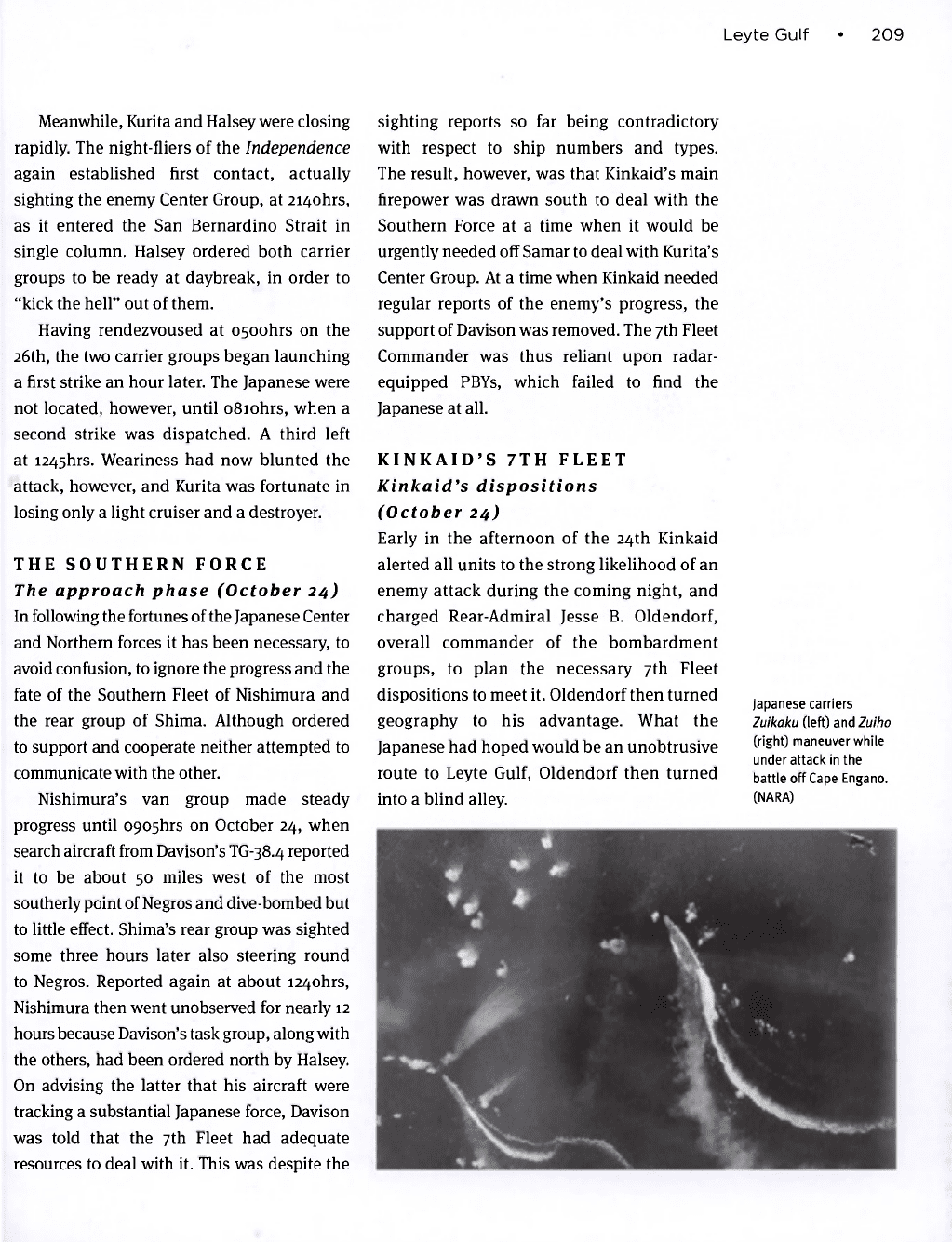
Leyte Gulf • 209
Meanwhile, Kurita and Halsey were closing
rapidly. The night-fliers of the Independence
again established first contact, actually
sighting the enemy Center Group, at 2i4ohrs,
as it entered the San Bernardino Strait in
single column. Halsey ordered both carrier
groups to be ready at daybreak, in order to
"kick the hell" out of them.
Having rendezvoused at osoohrs on the
26th, the two carrier groups began launching
a first strike an hour later. The Japanese were
not located, however, until o8iohrs, when a
second strike was dispatched. A third left
at i245hrs. Weariness had now blunted the
attack, however, and Kurita was fortunate in
losing only a light cruiser and a destroyer.
THE SOUTHERN FORCE
The approach phase (October 24)
In following the fortunes of the Japanese Center
and Northern forces it has been necessary, to
avoid confusion, to ignore the progress and the
fate of the Southern Fleet of Nishimura and
the rear group of Shima. Although ordered
to support and cooperate neither attempted to
communicate with the other.
Nishimura's van group made steady
progress until 0905hrs on October 24, when
search aircraft from Davison's TG-38.4 reported
it to be about 50 miles west of the most
southerly point of Negros and dive-bombed but
to little effect. Shima's rear group was sighted
some three hours later also steering round
to Negros. Reported again at about i24ohrs,
Nishimura then went unobserved for nearly 12
hours because Davison's task group, along with
the others, had been ordered north by Halsey.
On advising the latter that his aircraft were
tracking a substantial Japanese force, Davison
was told that the 7th Fleet had adequate
resources to deal with it. This was despite the
sighting reports so far being contradictory
with respect to ship numbers and types.
The result, however, was that Kinkaid's main
firepower was drawn south to deal with the
Southern Force at a time when it would be
urgently needed off Samar to deal with Kurita's
Center Group. At a time when Kinkaid needed
regular reports of the enemy's progress, the
support of Davison was removed. The 7th Fleet
Commander was thus reliant upon radar-
equipped PBYs, which failed to find the
Japanese at all.
KINKAID'S 7TH FLEET
Kinkaid's dispositions
(October 24)
Early in the afternoon of the 24th Kinkaid
alerted all units to the strong likelihood of an
enemy attack during the coming night, and
charged Rear-Admiral Jesse B. Oldendorf,
overall commander of the bombardment
groups, to plan the necessary 7th Fleet
dispositions to meet it. Oldendorf then turned
geography to his advantage. What the
Japanese had hoped would be an unobtrusive
route to Leyte Gulf, Oldendorf then turned
into a blind alley.
Japanese carriers
Zuikaku (left) and Zuiho
(right) maneuver while
under attack in the
battle off Cape Engano.
(NARA)
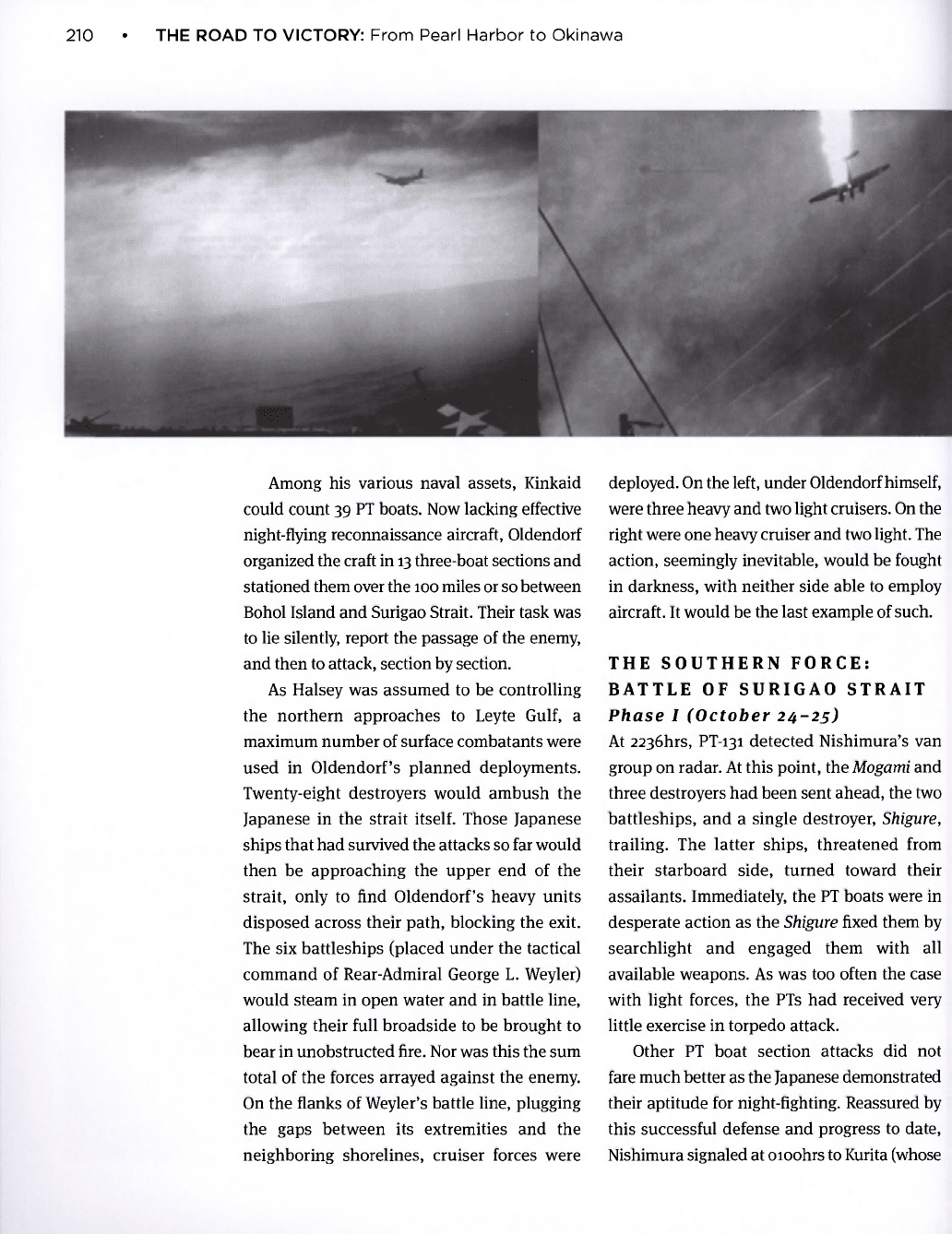
210 • THE ROAD TO VICTORY: From Pearl Harbor to Okinawa
Among his various naval assets, Kinkaid
could count 39 PT boats. Now lacking effective
night-flying reconnaissance aircraft, Oldendorf
organized the craft in 13 three-boat sections and
stationed them over the 100 miles or so between
Bohol Island and Surigao Strait. Their task was
to lie silently, report the passage of the enemy,
and then to attack, section by section.
As Halsey was assumed to be controlling
the northern approaches to Leyte Gulf, a
maximum number of surface combatants were
used in Oldendorf's planned deployments.
Twenty-eight destroyers would ambush the
Japanese in the strait itself. Those Japanese
ships that had survived the attacks so far would
then be approaching the upper end of the
strait, only to find Oldendorf's heavy units
disposed across their path, blocking the exit.
The six battleships (placed under the tactical
command of Rear-Admiral George L. Weyler)
would steam in open water and in battle line,
allowing their full broadside to be brought to
bear in unobstructed fire. Nor was this the sum
total of the forces arrayed against the enemy.
On the flanks of Weyler's battle line, plugging
the gaps between its extremities and the
neighboring shorelines, cruiser forces were
deployed. On the left, under Oldendorf himself,
were three heavy and two light cruisers. On the
right were one heavy cruiser and two light. The
action, seemingly inevitable, would be fought
in darkness, with neither side able to employ
aircraft. It would be the last example of such.
THE SOUTHERN FORCE:
BATTLE OF SURIGAO STRAIT
Phase I (October 24-25)
At 2236hrs, PT-131 detected Nishimura's van
group on radar. At this point, the Mogami and
three destroyers had been sent ahead, the two
battleships, and a single destroyer, Shigure,
trailing. The latter ships, threatened from
their starboard side, turned toward their
assailants. Immediately, the PT boats were in
desperate action as the Shigure fixed them by
searchlight and engaged them with all
available weapons. As was too often the case
with light forces, the PTs had received very
little exercise in torpedo attack.
Other PT boat section attacks did not
fare much better as the Japanese demonstrated
their aptitude for night-fighting. Reassured by
this successful defense and progress to date,
Nishimura signaled at oioohrs to Kurita (whose
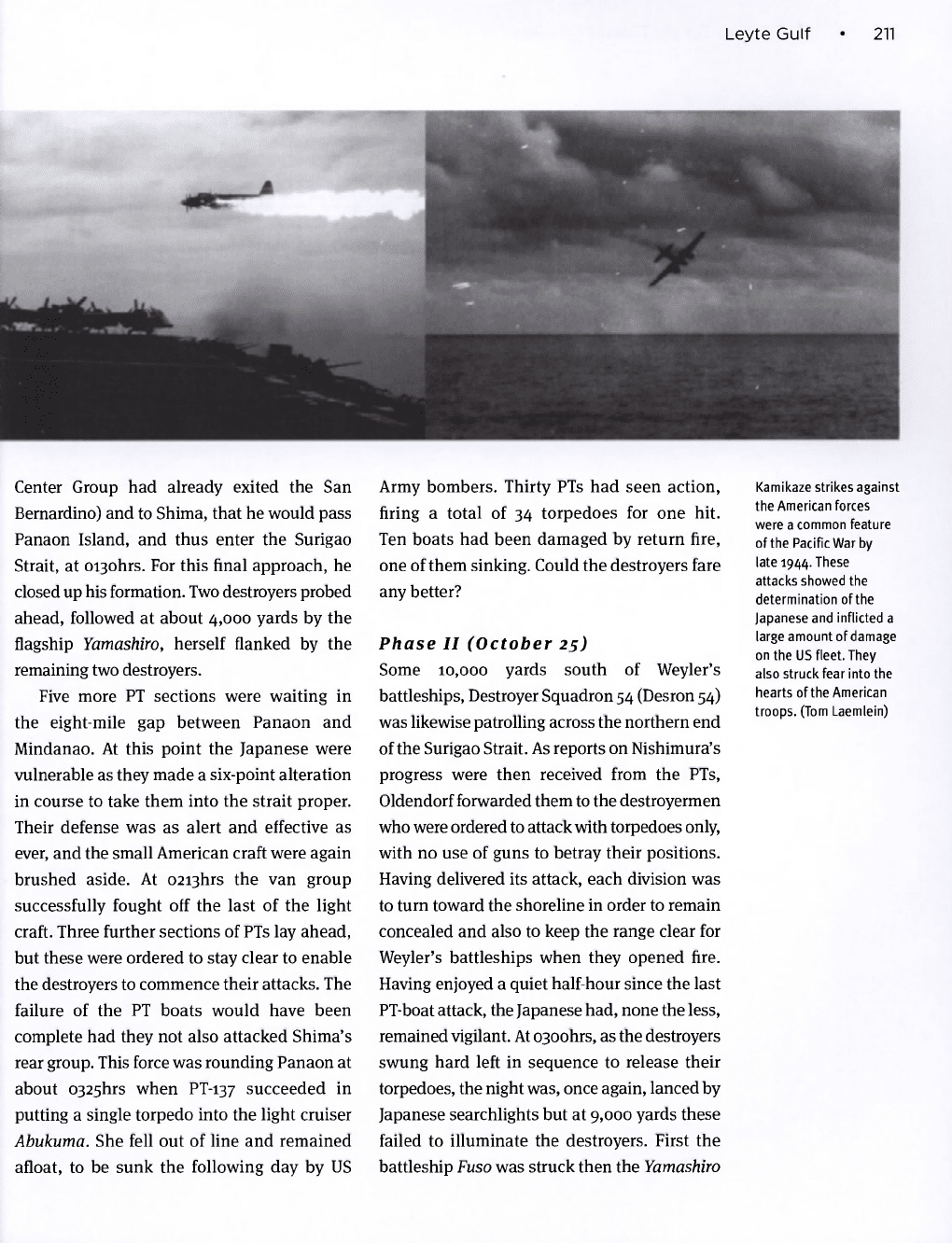
Leyte Gulf • 211
Center Group had already exited the San
Bernardino) and to Shima, that he would pass
Panaon Island, and thus enter the Surigao
Strait, at oi3ohrs. For this final approach, he
closed up his formation. Two destroyers probed
ahead, followed at about 4,000 yards by the
flagship Yamashiro, herself flanked by the
remaining two destroyers.
Five more PT sections were waiting in
the eight-mile gap between Panaon and
Mindanao. At this point the Japanese were
vulnerable as they made a six-point alteration
in course to take them into the strait proper.
Their defense was as alert and effective as
ever, and the small American craft were again
brushed aside. At 02i3hrs the van group
successfully fought off the last of the light
craft. Three further sections of PTs lay ahead,
but these were ordered to stay clear to enable
the destroyers to commence their attacks. The
failure of the PT boats would have been
complete had they not also attacked Shima's
rear group. This force was rounding Panaon at
about 0325hrs when PT-137 succeeded in
putting a single torpedo into the light cruiser
Abukuma. She fell out of line and remained
afloat, to be sunk the following day by US
Army bombers. Thirty PTs had seen action,
firing a total of 34 torpedoes for one hit.
Ten boats had been damaged by return fire,
one of them sinking. Could the destroyers fare
any better?
Phase II (October 25)
Some 10,000 yards south of Weyler's
battleships, Destroyer Squadron 54 (Desron 54)
was likewise patrolling across the northern end
of the Surigao Strait. As reports on Nishimura's
progress were then received from the PTs,
Oldendorf forwarded them to the destroyermen
who were ordered to attack with torpedoes only,
with no use of guns to betray their positions.
Having delivered its attack, each division was
to turn toward the shoreline in order to remain
concealed and also to keep the range clear for
Weyler's battleships when they opened fire.
Having enjoyed a quiet half-hour since the last
PT-boat attack, the Japanese had, none the less,
remained vigilant. At 0300hrs, as the destroyers
swung hard left in sequence to release their
torpedoes, the night was, once again, lanced by
Japanese searchlights but at 9,000 yards these
failed to illuminate the destroyers. First the
battleship Fuso was struck then the Yamashiro
Kamikaze strikes against
the American forces
were a common feature
of the Pacific War by
late 1944. These
attacks showed the
determination of the
Japanese and inflicted a
large amount of damage
on the US fleet. They
also struck fear into the
hearts of the American
troops. (Tom Laemlein)
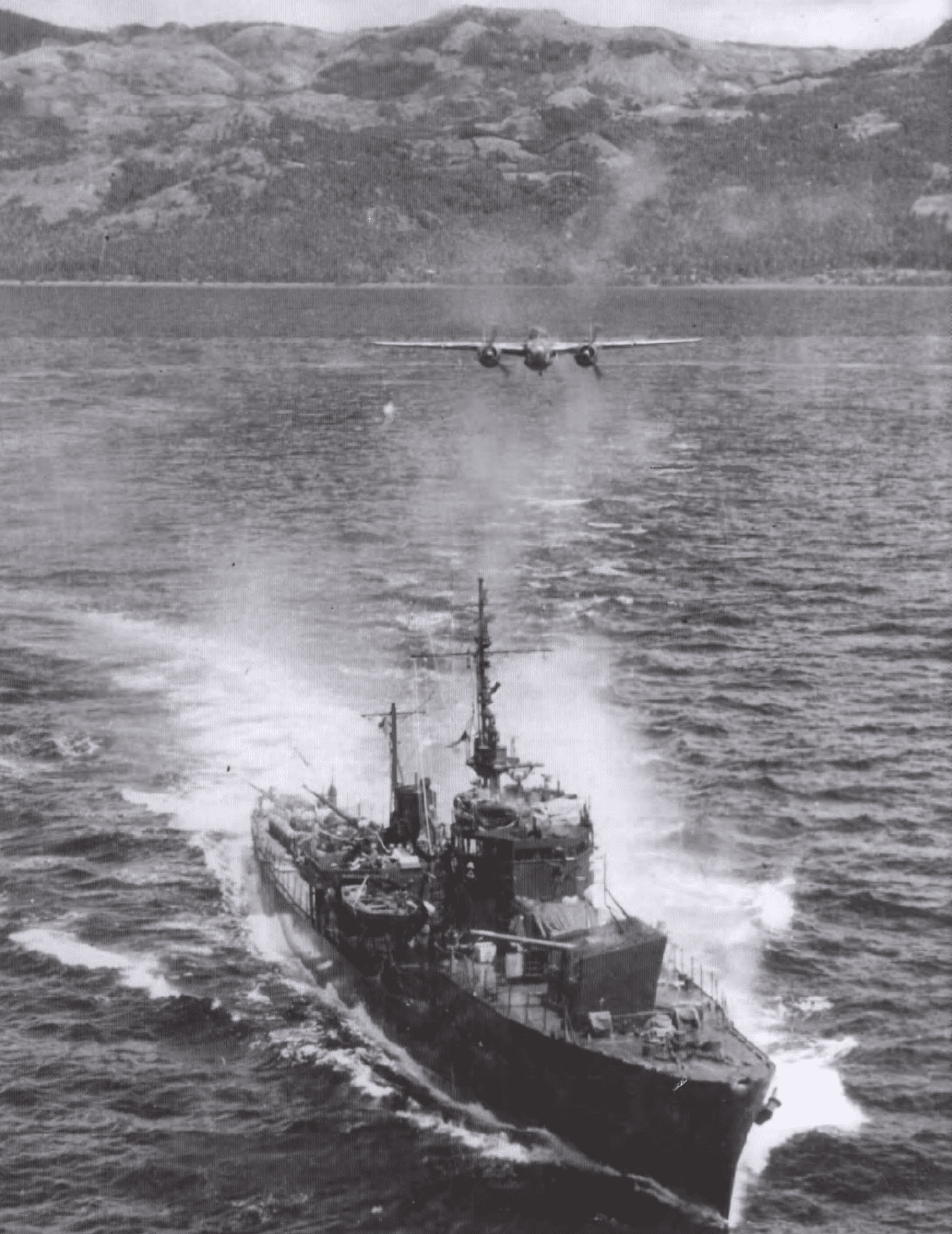
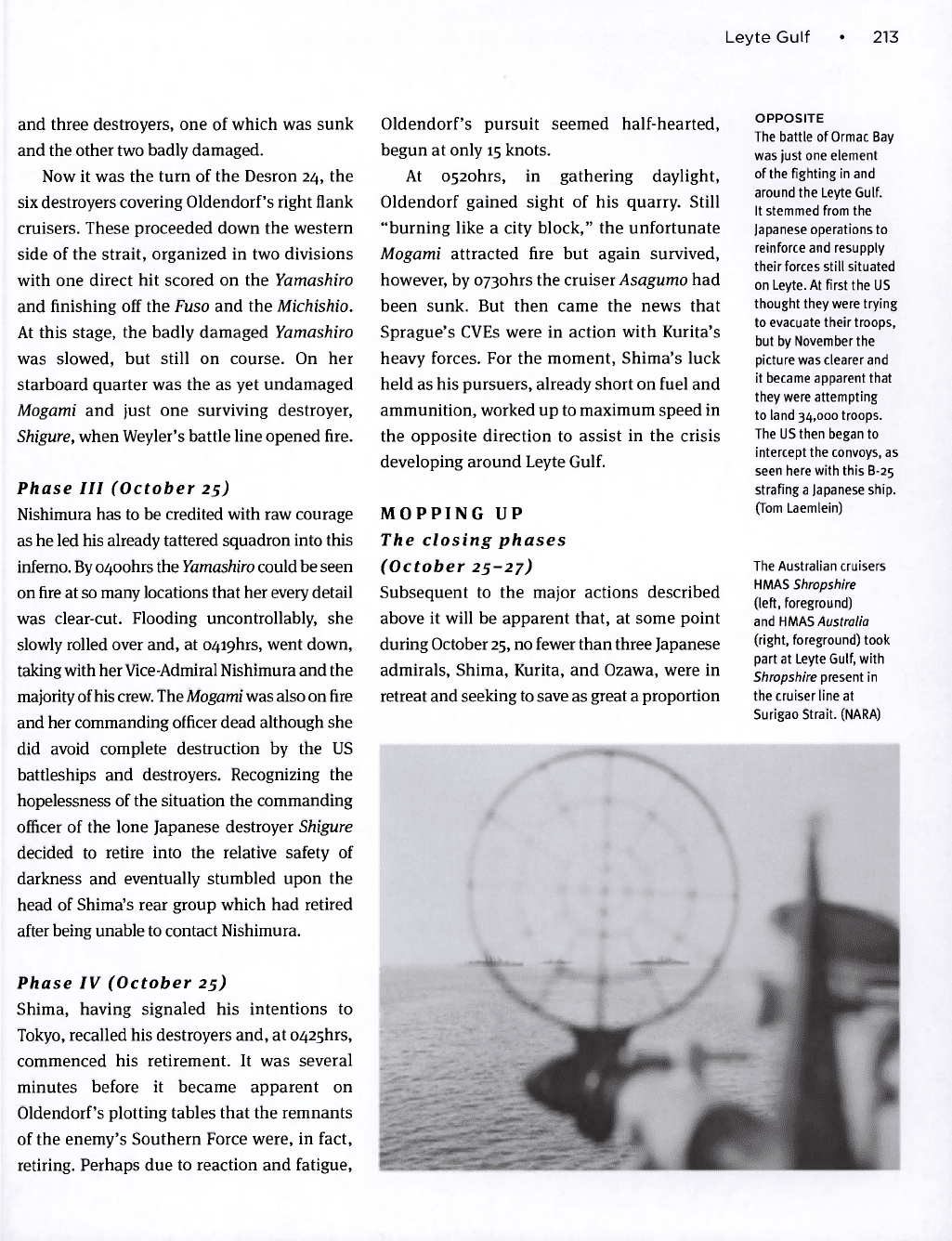
Leyte Gulf • 213
and three destroyers, one of which was sunk
and the other two badly damaged.
Now it was the turn of the Desron 24, the
six destroyers covering Oldendorf's right flank
cruisers. These proceeded down the western
side of the strait, organized in two divisions
with one direct hit scored on the Yamashiro
and finishing off the Fuso and the Michishio.
At this stage, the badly damaged Yamashiro
was slowed, but still on course. On her
starboard quarter was the as yet undamaged
Mogami and just one surviving destroyer,
Shigure, when Weyler's battle line opened fire.
Phase III (October 25)
Nishimura has to be credited with raw courage
as he led his already tattered squadron into this
inferno. By o4oohrs the Yamashiro could be seen
on fire at so many locations that her every detail
was clear-cut. Flooding uncontrollably, she
slowly rolled over and, at 04i9hrs, went down,
taking with her Vice-Admiral Nishimura and the
majority of his crew. The Mogami was also on fire
and her commanding officer dead although she
did avoid complete destruction by the US
battleships and destroyers. Recognizing the
hopelessness of the situation the commanding
officer of the lone Japanese destroyer Shigure
decided to retire into the relative safety of
darkness and eventually stumbled upon the
head of Shima's rear group which had retired
after being unable to contact Nishimura.
Phase IV (October 25)
Shima, having signaled his intentions to
Tokyo, recalled his destroyers and, at 0425hrs,
commenced his retirement. It was several
minutes before it became apparent on
Oldendorf's plotting tables that the remnants
of the enemy's Southern Force were, in fact,
retiring. Perhaps due to reaction and fatigue,
Oldendorf's pursuit seemed half-hearted,
begun at only 15 knots.
At 0520hrs, in gathering daylight,
Oldendorf gained sight of his quarry. Still
"burning like a city block," the unfortunate
Mogami attracted fire but again survived,
however, by 0730hrs the cruiser Asagumo had
been sunk. But then came the news that
Sprague's CVEs were in action with Kurita's
heavy forces. For the moment, Shima's luck
held as his pursuers, already short on fuel and
ammunition, worked up to maximum speed in
the opposite direction to assist in the crisis
developing around Leyte Gulf.
MOPPING UP
The closing phases
(October 25-27)
Subsequent to the major actions described
above it will be apparent that, at some point
during October 25, no fewer than three Japanese
admirals, Shima, Kurita, and Ozawa, were in
retreat and seeking to save as great a proportion
OPPOSITE
The battle of Ormac Bay
was just one element
of the fighting in and
around the Leyte Gulf.
It stemmed from the
Japanese operations to
reinforce and resupply
their forces still situated
on Leyte. At first the US
thought they were trying
to evacuate their troops,
but by November the
picture was clearer and
it became apparent that
they were attempting
to land 34,000 troops.
The US then began to
intercept the convoys, as
seen here with this B-25
strafing a Japanese ship.
(Tom Laemlein)
The Australian cruisers
HMAS Shropshire
(left, foreground)
and HMAS Australia
(right, foreground) took
part at Leyte Gulf, with
Shropshire present in
the cruiser line at
Surigao Strait. (NARA)
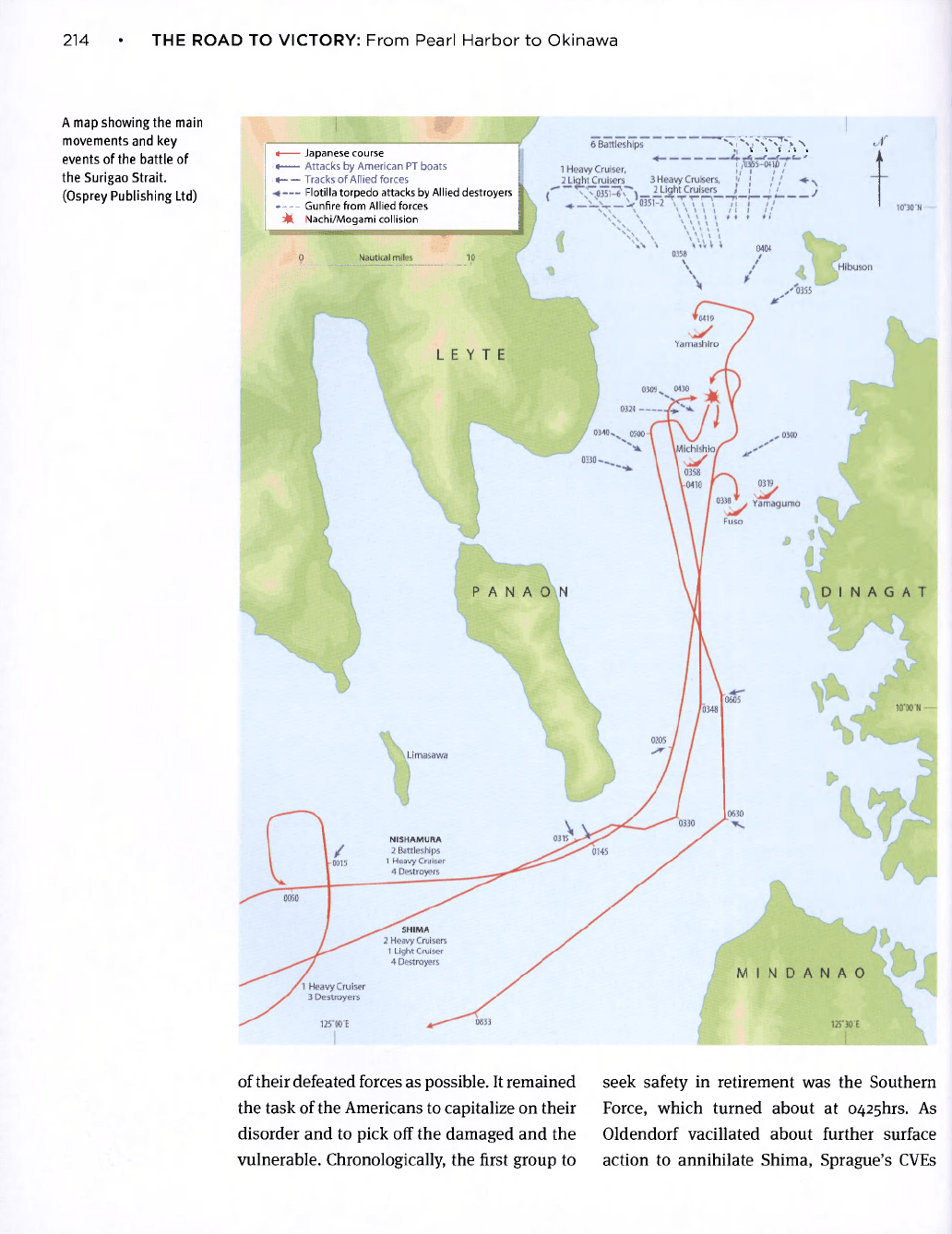
214 • THE ROAD TO VICTORY: From Pearl Harbor to Okinawa
A map showing the main
movements and key
events of the battle of
the Surigao Strait.
(Osprey Publishing Ltd)
< Japanese course
* Attacks by American PT boats
• Tracks of Allied forces
— Flotilla torpedo attacks by Allied destroyers
*— Gunfire from Allied forces
^fk Nachi/Mogami collision
N i Ni\
\T
>
'»
\
v \ t , \ i
of their defeated forces as possible. It remained
the task of the Americans to capitalize on their
disorder and to pick off the damaged and the
vulnerable. Chronologically, the first group to
seek safety in retirement was the Southern
Force, which turned about at 0425hrs. As
Oldendorf vacillated about further surface
action to annihilate Shima, Sprague's CVEs
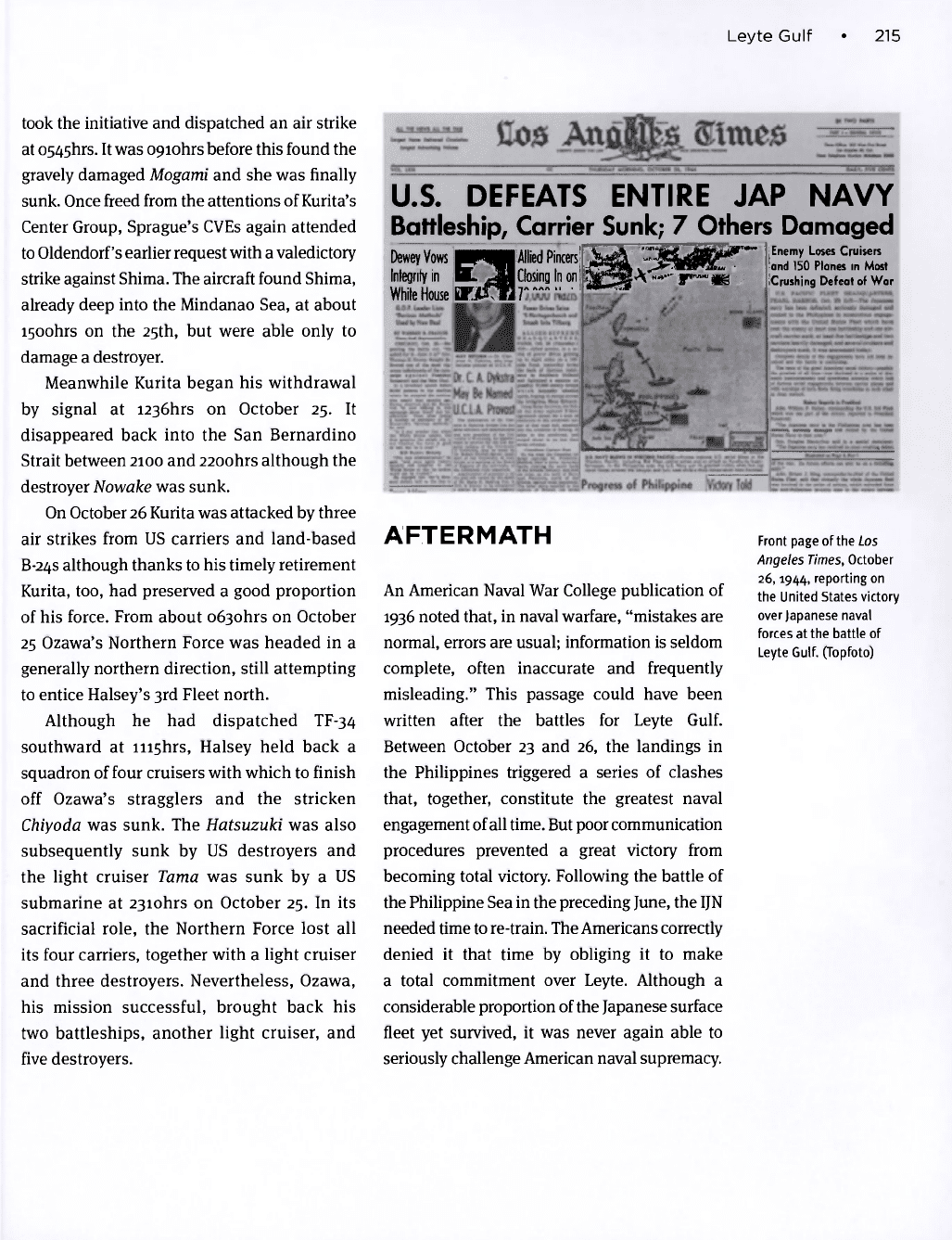
Leyte Gulf • 215
took the initiative and dispatched an air strike
at 0545hrs. It was 09i0hrs before this found the
gravely damaged Mogami and she was finally
sunk. Once freed from the attentions of Kurita's
Center Group, Sprague's CVEs again attended
to Oldendorf's earlier request with a valedictory
strike against Shima. The aircraft found Shima,
already deep into the Mindanao Sea, at about
isoohrs on the 25th, but were able only to
damage a destroyer.
Meanwhile Kurita began his withdrawal
by signal at i236hrs on October 25. It
disappeared back into the San Bernardino
Strait between 2100 and 2200hrs although the
destroyer Nowake was sunk.
On October 26 Kurita was attacked by three
air strikes from US carriers and land-based
B-24S although thanks to his timely retirement
Kurita, too, had preserved a good proportion
of his force. From about o63ohrs on October
25 Ozawa's Northern Force was headed in a
generally northern direction, still attempting
to entice Halsey's 3rd Fleet north.
Although he had dispatched TF-34
southward at liighrs, Halsey held back a
squadron of four cruisers with which to finish
off Ozawa's stragglers and the stricken
Chiyoda was sunk. The Hatsuzuki was also
subsequently sunk by US destroyers and
the light cruiser Tama was sunk by a US
submarine at 23iohrs on October 25. In its
sacrificial role, the Northern Force lost all
its four carriers, together with a light cruiser
and three destroyers. Nevertheless, Ozawa,
his mission successful, brought back his
two battleships, another light cruiser, and
five destroyers.
AFTERMATH
An American Naval War College publication of
1936 noted that, in naval warfare, "mistakes are
normal, errors are usual; information is seldom
complete, often inaccurate and frequently
misleading." This passage could have been
written after the battles for Leyte Gulf.
Between October 23 and 26, the landings in
the Philippines triggered a series of clashes
that, together, constitute the greatest naval
engagement of all time. But poor communication
procedures prevented a great victory from
becoming total victory. Following the battle of
the Philippine Sea in the preceding June, the IJN
needed time to re-train. The Americans correctly
denied it that time by obliging it to make
a total commitment over Leyte. Although a
considerable proportion of the Japanese surface
fleet yet survived, it was never again able to
seriously challenge American naval supremacy.
Front page of the Los
Angeles Times, October
26,1944, reporting on
the United States victory
over Japanese naval
forces at the battle of
Leyte Gulf. (Topfoto)
U.S. DEFEATS ENTIRE JAP NAVY
Battleship, Carrier Sunk; 7 Others Damaged
Dewey Vow Allied
Pincers^^
En
^
y
n
L
P
?
s Crui
T,
11 'i. • iw T|« • . , . and 150 Planes in Most
Integrity in
HL^||Cteingln0n V^"^
"-*
Crushing Defeat
of
War
White House
^^
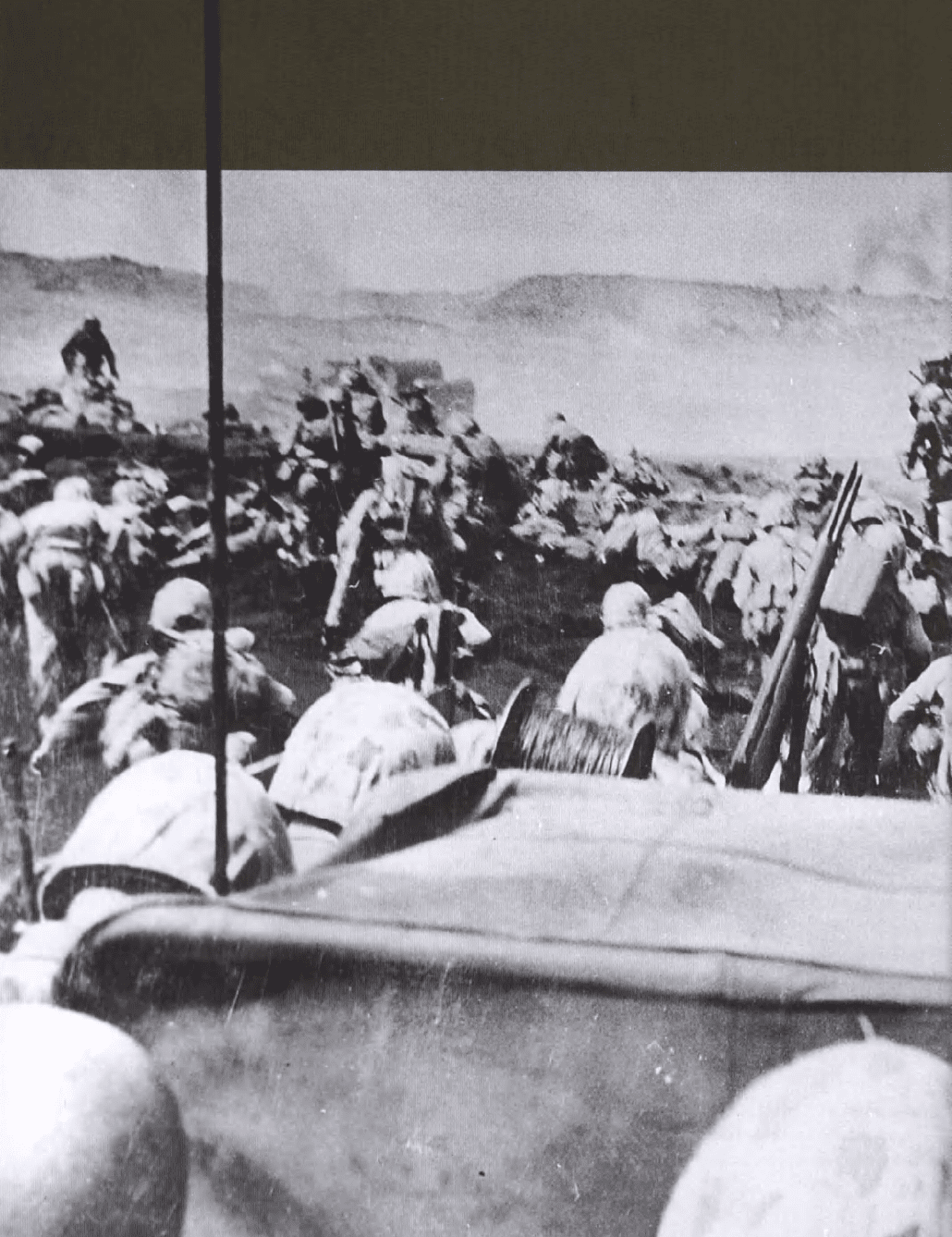
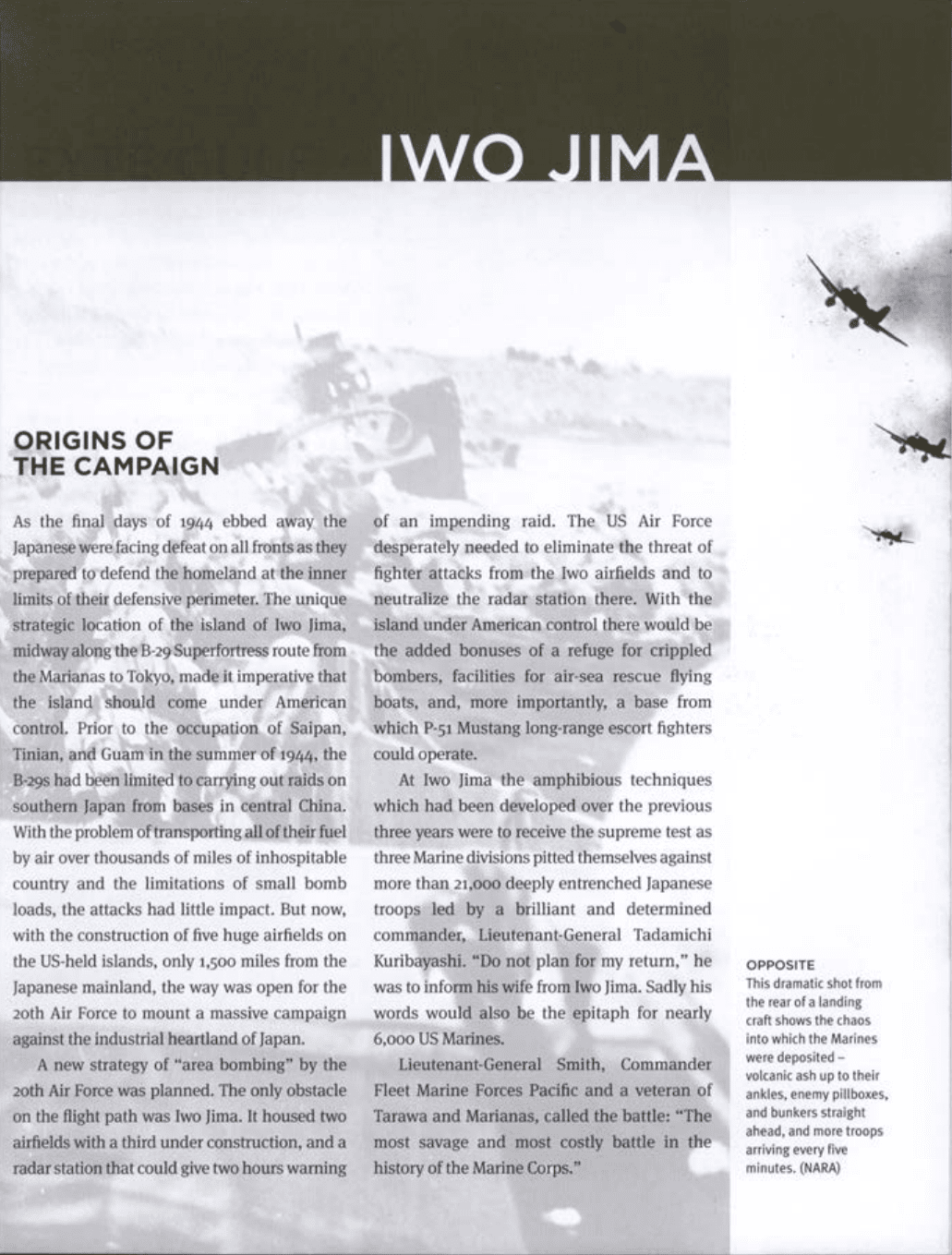
ORIGINS OF
THE CAMPAIGN
As the final days of 1944 ebbed away the
Japanese were facing defeat on all fronts as they
prepared to defend the homeland at the inner
limits of their defensive perimeter. The unique
strategic location of the island of Iwo Jima,
midway along the B-29 Superfortress route from
the Marianas to Tokyo, made it imperative that
the island should come under American
control. Prior to the occupation of Saipan,
Tinian, and Guam in the summer of 1944, the
B-29S had been limited to carrying out raids on
southern Japan from bases in central China.
With the problem of transporting all of their fuel
by air over thousands of miles of inhospitable
country and the limitations of small bomb
loads, the attacks had little impact. But now,
with the construction of five huge airfields on
the US-held islands, only 1,500 miles from the
Japanese mainland, the way was open for the
20th Air Force to mount a massive campaign
against the industrial heartland of Japan.
A new strategy of "area bombing" by the
20th Air Force was planned. The only obstacle
on the flight path was Iwo Jima. It housed two
airfields with a third under construction, and a
radar station that could give two hours warning
of an impending raid. The US Air Force
desperately needed to eliminate the threat of
fighter attacks from the Iwo airfields and to
neutralize the radar station there. With the
island under American control there would be
the added bonuses of a refuge for crippled
bombers, facilities for air-sea rescue flying
boats, and, more importantly, a base from
which P-51 Mustang long-range escort fighters
could operate.
At Iwo Jima the amphibious techniques
which had been developed over the previous
three years were to receive the supreme test as
three Marine divisions pitted themselves against
more than 21,000 deeply entrenched Japanese
troops led by a brilliant and determined
commander, Lieutenant-General Tadamichi
Kuribayashi. "Do not plan for my return," he
was to inform his wife from Iwo Jima. Sadly his
words would also be the epitaph for nearly
6,000 US Marines.
Lieutenant-General Smith, Commander
Fleet Marine Forces Pacific and a veteran of
Tarawa and Marianas, called the battle: "The
most savage and most costly battle in the
history of the Marine Corps."
OPPOSITE
This dramatic shot from
the rear of a landing
craft shows the chaos
into which the Marines
were deposited -
volcanic ash up to their
ankles, enemy pillboxes,
and bunkers straight
ahead, and more troops
arriving every five
minutes. (NARA)
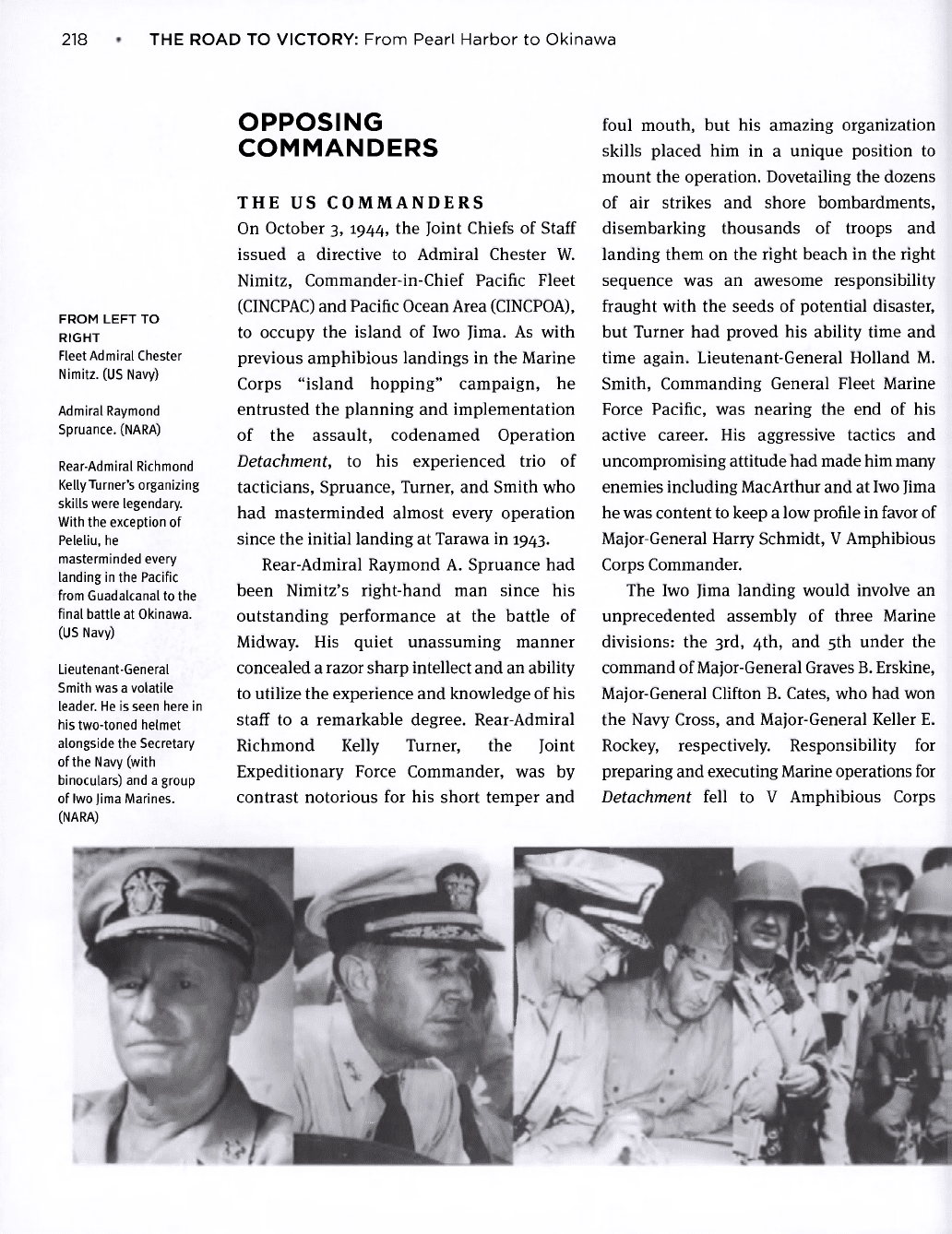
218 • THE ROAD TO VICTORY: From Pearl Harbor to Okinawa
FROM LEFT TO
RIGHT
Fleet Admiral Chester
Nimitz. (US Navy)
Admiral Raymond
Spruance. (NARA)
Rear-Admiral Richmond
Kelly Turner's organizing
skills were legendary.
With the exception of
Peleliu, he
masterminded every
landing in the Pacific
from Guadalcanal to the
final battle at Okinawa.
(US Navy)
Lieutenant-General
Smith was a volatile
leader. He is seen here in
his two-toned helmet
alongside the Secretary
of the Navy (with
binoculars) and a group
of Iwo Jima Marines.
(NARA)
OPPOSING
COMMANDERS
THE US COMMANDERS
On October 3, 1944, the Joint Chiefs of Staff
issued a directive to Admiral Chester W.
Nimitz, Commander-in-Chief Pacific Fleet
(CINCPAC) and Pacific Ocean Area (CINCPOA),
to occupy the island of Iwo Jima. As with
previous amphibious landings in the Marine
Corps "island hopping" campaign, he
entrusted the planning and implementation
of the assault, codenamed Operation
Detachment, to his experienced trio of
tacticians, Spruance, Turner, and Smith who
had masterminded almost every operation
since the initial landing at Tarawa in 1943.
Rear-Admiral Raymond A. Spruance had
been Nimitz's right-hand man since his
outstanding performance at the battle of
Midway. His quiet unassuming manner
concealed a razor sharp intellect and an ability
to utilize the experience and knowledge of his
staff to a remarkable degree. Rear-Admiral
Richmond Kelly Turner, the Joint
Expeditionary Force Commander, was by
contrast notorious for his short temper and
foul mouth, but his amazing organization
skills placed him in a unique position to
mount the operation. Dovetailing the dozens
of air strikes and shore bombardments,
disembarking thousands of troops and
landing them on the right beach in the right
sequence was an awesome responsibility
fraught with the seeds of potential disaster,
but Turner had proved his ability time and
time again. Lieutenant-General Holland M.
Smith, Commanding General Fleet Marine
Force Pacific, was nearing the end of his
active career. His aggressive tactics and
uncompromising attitude had made him many
enemies including MacArthur and at Iwo Jima
he was content to keep a low profile in favor of
Major-General Harry Schmidt, V Amphibious
Corps Commander.
The Iwo Jima landing would involve an
unprecedented assembly of three Marine
divisions: the 3rd, 4th, and 5th under the
command of Major-General Graves B. Erskine,
Major-General Clifton B. Cates, who had won
the Navy Cross, and Major-General Keller E.
Rockey, respectively. Responsibility for
preparing and executing Marine operations for
Detachment fell to V Amphibious Corps
